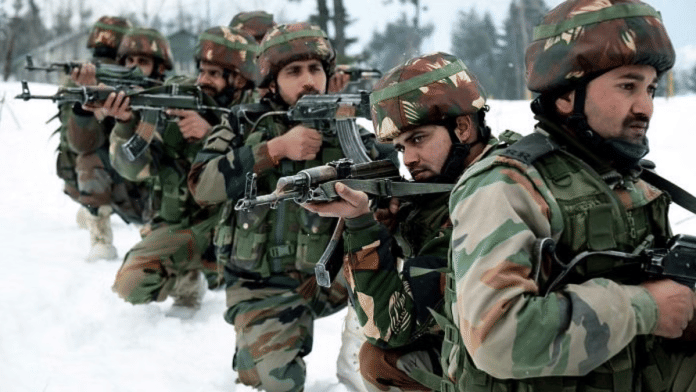New Delhi: Facing a two-front challenge from Pakistan and China, the Indian Army is preparing to deploy its newly formed Bhairav Commando battalions in active service by the end of this month.
According to sources in the defence and security establishment, five Bhairav battalions are being positioned along key frontiers. “Three units are being deployed along the northern frontier with China and Pakistan, one in the northeast and another on the western front,” a source told ThePrint.
The newly raised Bhairav Commandos will be tasked with cross-border interdiction, reconnaissance and disruption of adversary positions, permitting the Special Forces to focus on more complex, high-priority missions.
The sources explained that similar to Special Forces, each Bhairav battalion will be trained and assigned according to the requirements of the operational terrain but they will not be as heavily armed nor assigned the most complex missions.
“Each Bhairav battalion comprises approximately 250 soldiers trained in a two-phase system, initial preparation at their parent unit’s training centres, followed by advanced exercises alongside Special Forces units. These commandos will substantially augment our capabilities and at least 23 such units are expected to be operational by the end of October,” one of the aforementioned sources said.
The induction of Bhairav Commandos forms part of a broader restructuring drive outlined by Army chief General Upendra Dwivedi last month. The announcement came after it was revealed that China had actively aided Pakistan during Operation Sindoor, providing real-time intelligence on Indian troop movements and weapon deployments.
The hostilities with Pakistan in May also underlined how drones, loitering munitions and networked ISR (Intelligence, Surveillance, and Reconnaissance) platforms can hit enemy positions with swift precision. Subsequently, parallel to the Bhairav units, the Army has also begun modernising its artillery to operate effectively in drone-saturated battlefields.
The sources said the Army is also all set to get Shaktibaan regiments (specialised artillery regiments) by the end of this month, which are designed to be fully unmanned aerial system (UAS)-driven. “Each Shaktibaan regiment will comprise three batteries, two with long-and medium-range loitering munitions and a third equipped with swarm drones and remotely piloted aircraft systems (RPAS).”
The sources clarified that these regiments are being raised under a ‘Save and Raise’ approach, repurposing existing assets rather than creating entirely new units.
Each standard artillery regiment will also incorporate Divyastra Batteries, with some batteries expected to be operational by the end of this month. Traditionally, an artillery regiment has three batteries and each battery subdivided into two troops, forming the basic tactical unit.
“Under this, the first two batteries will have eight medium artillery guns each, while the third battery will be a composite battery equipped with loitering munitions and dual-role RPAS. This new configuration will permit us to carry out autonomous “sensor-to-shooter” missions which will provide real-time surveillance and engagement without reliance on external intelligence,” one of the sources explained.
In addition, the Army is also raising Rudra all-arms brigades, which integrate infantry, armour, mechanised infantry, artillery, engineers, air defence, UAVs and Special Forces under a single command. Sources said two such brigades are being converted and will be all set to be positioned along the borders with China and Pakistan.
The sources clarified that, while Rudra brigades share certain characteristics with Integrated Battle Groups (IBGs), they differ in scale and structure.
“Unlike the IBG concept, which is expected to be commanded by a Major-General and proposed eliminating the rank of Brigadier, each Rudra Brigade will be led by a Brigadier, as the designation implies,” the source said, adding that IBGs are designed as scaled-down divisions, Rudra brigades are slightly larger than a standard brigade formation.
(Edited by Tony Rai)
Also Read: ‘Next war may come sooner than expected, will require whole-of-nation approach’—Army chief




